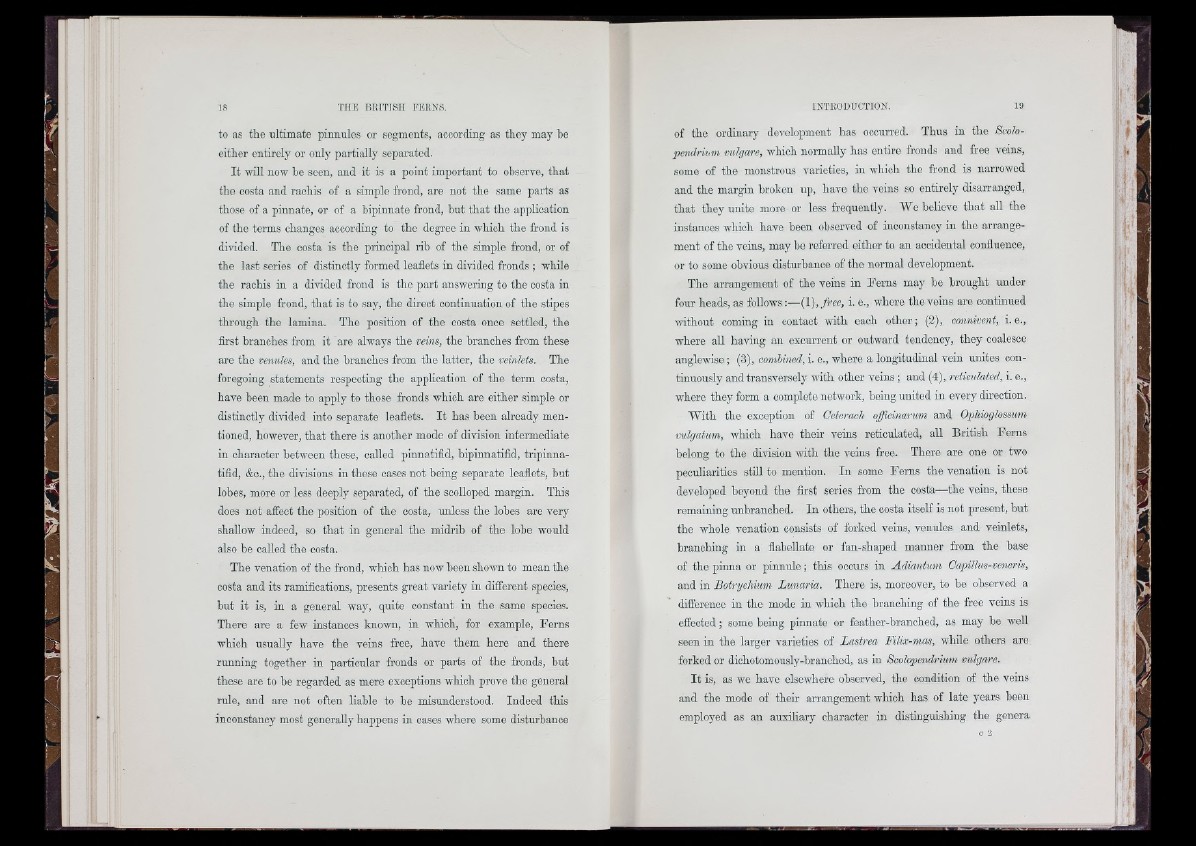
to as the ultimate pinnules or segments, according as they may be
either entirely or only partially separated.
I t will now ho seen, and it is a point important to observe, that
the costa and rachis of a simple frond, are not the same parts as
those of a pinnate, or of a bipinnate frond, but that the application
of the terms changes according to tho degree in which the frond is
divided. The costa is the principal rib of the simple frond, or of
the last series of distinctly formed leaflets in divided fronds ; while
the raohis in a divided frond is tho part answering to the costa in
the simple frond, that is to say, the direct continuation of the stipes
through the lamina. The position of the costa once settled, the
first branches from it are always the veins, the branches from these
are the venules, and the branches from the latter, the veinlets. The
foregoing statements respecting the application of the term costa,
have been made to apply to those fronds which are either simple or
distinctly divided into separate leaflets. I t has been already mentioned,
however, th a t there is another mode of division intermediate
in character between these, called pinnatifid, hipinnatifid, tripinnatifid,
&o., the divisions in these cases not being separate leaflets, hut
lobes, more or less deeply separated, of the scolloped margin. This
does not affect the position of the costa, unless the lobes are very
shallow indeed, so that in general the midrib of the lobe would
also be called the costa.
The venation of the frond, which has now been shown to mean the
costa and its ramifications, presents great variety in different species,
but it is, in a general way, quite constant in the same species.
There are a few instances known, in which, for example, Fenis
which usually have the veins free, have them here and there
running together in particular fronds or parts of the fronds, but
these are to be regarded as mere exceptions which prove the general
rule, and are not often liable to be misunderstood. Indeed this
inconstancy most generally happens in oases where some disturbance
of the ordinary development has occurred. Thus in the Scolo-
pendrmm vulgare, which normally has entire fronds and free veins,
some of the monstrous varieties, in which the frond is narrowed
and tho margin broken up, have the veins so ontirely disarranged,
that they unite more or less frequently. We believe that aU the
instances which have been observed of inconstancy in the arrangement
of the veins, may bo referred either to an accidental confluence,
or to some obvious disturbance of the normal development.
The arrangement of the veins in Ferns may be brought under
four heads, as follows :—if), free, i. e., where the veins are oontinned
without coming in contact vdth each other; (2), connivent, i.e.,
where all having an oxourrent or outward tendency, they coalesce
anglewise ; (3), combined, i. e., where a longitudinal vein unites continuously
and transversely vdth other veins ; and (4), reticulated, i. e.,
where they form a complete network, being united in every direction.
With the exception of Ceterach officinarmn and Ophioglossum
vulgatum, which have their veins reticulated, aU British Ferns
belong to the division with the veins free. There are one or two
peculiarities still to mention. In some Ferns the venation is not
developed beyond the first series from the costa—the veins, these
remaining unhranohed. In others, the costa itself is not present, but
the whole venation consists of forked veins, venules and veinlets,
branching in a flabellate or fan-shaped manner from the base
of tho pinna or pinnule ; this occurs in Adiantum Capillus-veneris,
and in Botrychium Lunaria. There is, moreover, to bo observed a
difference in the mode in which the branching of the free veins is
effected ; some being pinnate or feather-branched, as may he well
seen in the larger varieties of Lastrea Filix-mas, while others are
forked or dichotomously-branohed, as in Scolopendrium vulgare.
I t is, as we have elsewhere observed, the condition of the veins
and the mode of their arrangemont -which has of late years been
employed as an auxiliary character in distinguishing the genera
0 2